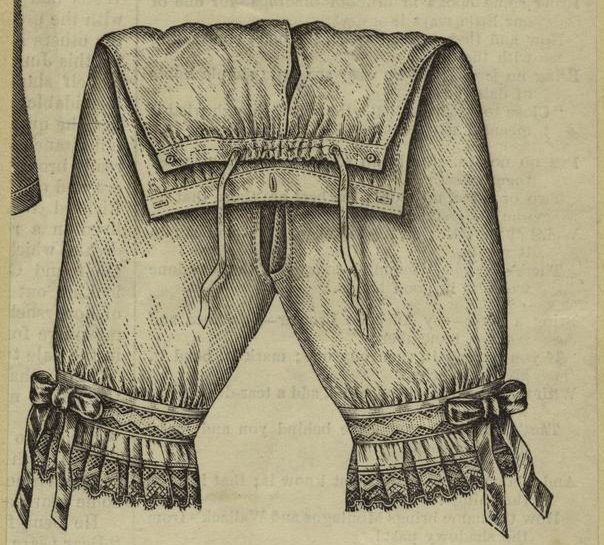
From the New York Public Library
I remember the first time I bought a pair of crotchless panties. I went to Fredrick’s of Hollywood and bought a set that comprised of ruffle-trimmed nipple-less bra and crotchless panties in a shiny black fabric. It seemed sexy at the time. I had imagined buying them ever since I saw them in Fredrick’s magazine ads when I was younger. When I put them on the fabric was a little cheap and uncomfortable. Don’t think I had them on for very long. I eventually found wearing a sexy pair of panties over a garter much sexier. That wouldn’t be the last time I wore crotchless undergarments. I would soon get into the world of historical reenactment and find myself wearing crotchless undergarments nearly every week, in the shape of Victorian drawers.
The idea of drawers being open at the crotch did not have the same erotic intention of the modern crotchless panty. In fact, up until the late 1700s women just wore a long chemise that went down past her knees under her dress, corset, and petticoats. Nothing was worn underneath since the skirts were long and the chemise and underskirts provided enough coverage. Undergarments that consisted of two legs that tied at the top but left the crotch area uncovered show up in the 1700s. It was thought that only prostitutes and women of questionable morals wore them. When dresses moved to a more natural shape at the end of the 1800’s this idea is discarded and pantalettes or pantaloons become acceptable. There was some reluctance to accept them at first as having something on underneath that resembled pants did not meet with immediate approval.
The reason split drawers are open at the crotch is to make going to the bathroom easier. When you have a corset and several layers of petticoats and skirts you can’t pull down underwear to sit. It’s easier to hike up your skirts and squat. Having been there and done that I can attest to the easy of the open crotch drawers. I once made the mistake and wrestled with my underwear in a bustle dress in a way that was completely exhausting and made me worry the underwear would win. My long cotton split drawers never once felt remotely sexy, even ones with pintucks, lace, and ribbons at the hem. My chemise came down to nearly my knees so nothing was exposed. In fact, I walked around in my skivvies in front of people often when I demonstrated how the Victorian woman dressed for a history event. One young gentleman found it difficult to talk to me in my underthings even though not a bit of skin below my sans cleavage neckline was exposed. Just the idea of me being in my underwear was enough to make him uncomfortable with my relative state of undress.
It interesting to see how we can go from going commando being perfectly acceptable but wearing tubes of cloth around our legs is immoral, to the idea of wearing a dress without panties bringing about a hefty dose of slut shaming. But then again we’ve gone from a glimpse of stocking being something shocking to the string bikini in less than a century. Our concept of what is considered scandalous in our clothing, even undergarments, can change in ways that seems odd to our modern sensibility. The idea of a certain style of underwear being acceptable while women of questionable morals only use another seems to be common in western dress. I imagine in several hundred years we may find what is acceptable under our clothes will change again.


![V0047298 Various sex aids, including dildos, artificial vulva, penis Credit: Wellcome Library, London. Wellcome Images images@wellcome.ac.uk http://wellcomeimages.org Various sex aids, including dildos, artificial vulva, penis supports etc. Colour woodcut, ca. 1830. Published: [ca. 1830] Copyrighted work available under Creative Commons Attribution only licence CC BY 4.0 http://creativecommons.org/licenses/by/4.0/](http://www.sexualhistorytour.com/wp-content/uploads/2016/04/Various_sex_aids_including_dildos_artificial_vulva_penis_Wellcome_V0047298-1024x852.jpg)

